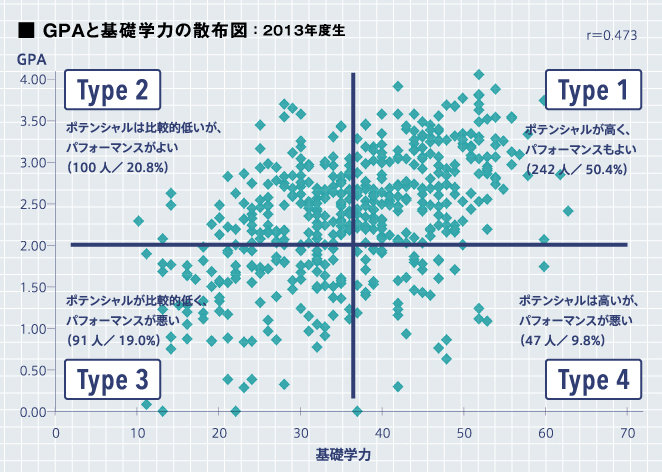成績を伸ばすためのサポートを探る
右上の図は入学時テストの結果(基礎学力)を横軸に、1年時終了時のGPA(学業成績)を縦軸にとった散布図です。この図から基礎学力が高いほど学業成績が高い傾向があることが読み取れますが、ばらつきが大きく、必ずしも傾向通りというわけではありません。
そこで、ある学年について「基礎学力と成績がどちらも高い(タイプ1)」、「基礎学力は低いが成績が良い(タイプ2)」、「どちらも低い(タイプ3)」、「基礎学力は高いが成績が低い(タイプ4)」の4タイプに分けてその特徴を分析しました。すると、タイプ2はアルバイトの時間が短い、タイプ3は部活やサークルにかける時間が長い、タイプ4は課題や試験準備に時間をかけず、ボランティアや行事に参加しない、などの傾向が見られました。この結果から、支援の方法や内容は、学生のタイプによって変える必要があることが浮き彫りになりました。
The diagram on the right is a scatter plot with the horizontal axis representing the results of the entrance examination test (basic academic ability) and the vertical axis representing the GPA (academic achievement) at the end of one year. The data figure reveals that the higher the basic academic ability is, the higher the academic performance tends to be, but the variation is large, which is not necessarily according to the trend.
Students were divided into 4 types for analysis. The results are as follows. Accordingly, for a certain grade, basic academic achievement and grade are both high (Type 1). The basic academic ability is low, but the grade is good (Type 2). Both are low (Type 3). The basic academic ability is high, but the grade is low (Type 4). Students were also asked about how much time they spent for some tasks. Results show that the time spent for part-time job was short (Type 2). For club activities and circles, the time spent was long (Type 3). There was not much time spent to prepare assignments and test preparation (Type 4). As for volunteering, students did not participate in volunteers or events. The results reveal that there is a need to change the support for content and method for learning according to the type of student.







